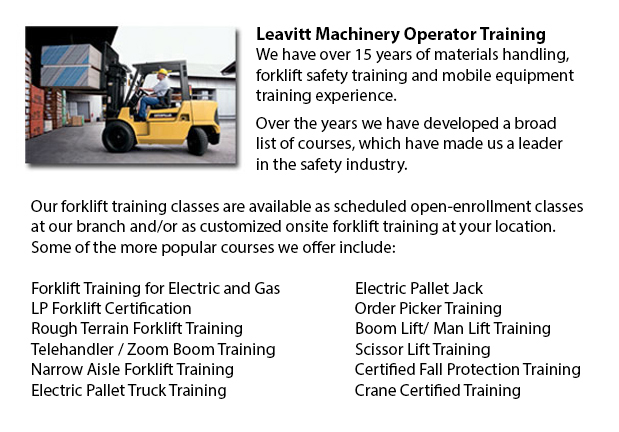
Pallet Stackers Training Oshawa - A pallet stacker is a kind of pallet jack that is utilized to transport, stack and lift palletized goods that are overly difficult for manual lifting. Its key purpose is to load and unload pallets on trucks, as well as transferring pallets to and from various places within a storage space or stockroom. On the whole pallet stackers are constructed of heavy duty materials to endure tremendous weights. Pallet stackers are often referred to as pallet jacks. They can be operated from a seated, upright or walk-behind position. Pallet jacks are separated into manual and powered types.
Some basic components comprise the pallet stacker. There are forks that slide underneath a pallet, capable of moving and raising it to a preferred height. The engine compartment or casing houses the gas-run, electronic or hydraulic equipment that powers the machine.
Commonly, pallet jacks come in walk-behind models that are hand-powered. This means that they are moved by pushing and pulling the stacker into its desired location, while raising the heavy pallets will be operated hydraulically making this task a great deal easier. Utilizing a foot pedal or handle raises the stacker's forks. Squeezing a lever or trigger returns the forks to the floor. These models of pallet stackers are perfect for lighter loads of up to approximately 1 ton or 907.18 kg.
Most stackers can accommodate the lifting of heavy weights to around 5 tons with both the gas or electric models. They are physically less demanding to maneuver than the labor-intensive versions due to the hydraulic power that hoists and lowers the forks. These styles are steered by rotating the handle in a specific direction. There is a button on the knob that functions to lift and lower the forks. A throttle found on the stacker's grips moves the device forward and in reverse. This type of equipment is generally known as a forklift and is used from a sit-down posture.
As the fork width, load limit and lift height fluctuate dramatically between individual models, picking the correct pallet stacker to suit the job is critical. Some stacker's lift height may permit several pallets to be stacked, while others might only tolerate two at a time. Certain types of these forklifts feature an adjustable fork in order to permit the stacker to slide under pallets of unusual sizes and shapes. These models are useful when a mixture of types of pallets are common within a workspace.
-
Doosan Forklift
Doosan Forklift Training Oshawa - Doosan Infracore Company Ltd. is an international and intercontinental company that features Defense Industry Products, Industrial Vehicles, Diesel Engines, Automation Systems, Machine Tools and Construction Equipme... More -
Rough Terrain Forklifts
Rough Terrain Forklifts Training Oshawa - There are in reality two categories of forklifts within the production industry, the rough terrain model and the industrial version. Rough terrain lift trucks appeared in the 1940's intended predominantly for... More -
Hyster Forklift
Hyster Forklift Training Oshawa - Hyster is an industry leader in the materials handling industry that has been in business for over 80 years. However, it started as a manufacturer of lifting machines and winches. Most of its production was focused... More -
Nissan Forklift
Nissan Forklift Training Oshawa - Nissan prides itself on reaching overall customer fulfillment when their buyer is enjoying one of their numerous trucks, cars or forklifts. Nissan Forklift branch is a wholly owned subsidiary of Nissan Motor Co. Ltd.... More -
Aerial Lifts
Aerial Lift Training Oshawa - Aerial lift trucks can be used to accomplish several unique duties performed in hard to reach aerial places. Many of the odd jobs associated with this kind of lift include performing regular maintenance on structures wit... More

Forklift Certification Oshawa
TOLL FREE: 1-888-254-6157
Oshawa, Ontario
forkliftcertificationoshawa.com
Email Us
About Us


